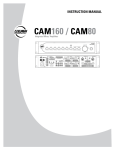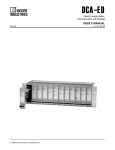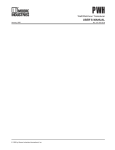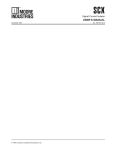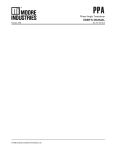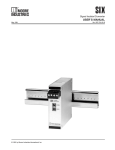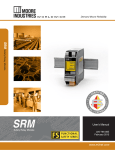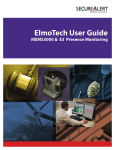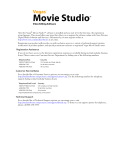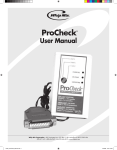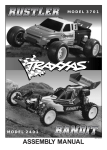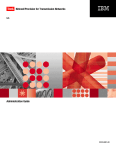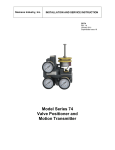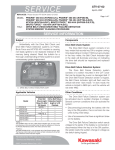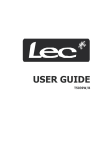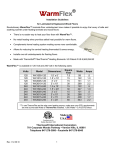Download USER`S MANUAL - Moore Industries International
Transcript
IPF Field-Mount Current-to-Pressure Transmitter USER’S MANUAL January 1992 © 1992 by Moore Industries-International, Inc. No. 170-702-00 C Table of Contents Introduction 1 Description 1 Calibration 3 Installation 8 Operation 12 Maintenance 12 Troubleshooting 16 TRADEMARKS: 1. Telfon® is a registered trademark of the DuPont Corporation. 2. Loctite® is a registered trademark of Loctite Incorporated. HR. DELIVERY 8 4 UnitedStates/Canada TOLLFREE 1-800-999-2900 United Kingdom FREEPHONE 0800 525107 Australia TOLLFREE 008 251928 Ask for the STAR Center 16650 Schoenborn Street Sepulveda, California 91343, U.S.A. Tel: (818) 894-7111 • Tlx: 65-1322 FAX: (818) 891-2816 CONNECT (MacNet): MIISEPULVEDA 1 Lloyds Court, Manor Royal, Crawley W. Sussex RH10-2QU, United Kingdom Tel: 0293 514488 • Tlx: 87667 FAX: 0293 536852 Moore Industries’ STAR* Center has a wide variety of quality instrumentation in stock and ready to ship. • Signal Transmitters • Temperature Transmitters • P/I and I/P Converters • Isolators and Converters • Indicators and Displays • Alarm Trips • Integrators and Totalizers • Power Transducers • Instrument Power Supplies • Racks, Rails and Enclosures Most instruments can be customized to meet your needs. Even then, you’ll never have to wait more than a few days. Moore Industries 3/18 Resolution Drive, Caringbah New South Wales 2229, Australia Tel: (02) 525-9177 • Tlx: 790-75914 FAX: (02) 525-7296 CENTER * Support, Technical Assistance, and Repair (our Quick-Ship Facility) IPF Page 1 Introduction The field-mount version of Moore Industries’ Currentto-Pressure Transmitter enclosed in an all-weather, thermoplastic housing is called the IPF. It is a rugged, two-wire transmitter whose design meets the specifications for several types of water- and dusttight, and corrosion-resistance certifications. The material used in the unit’s housing makes it ideal for use under even the most arduous of environmental conditions. This manual contains the descriptive and instructional information needed to install, operate, and maintain the IPF. It includes a brief explanation of the unit model number, a table of its performance and operational specifications, instructions for calibration, information on installation and maintenance procedures, and checklist of troubleshooting recommendations. Appendix A consists of information on instrumentquality air and filtration, essential for optimum IPF performance and reliability. Notes and Cautions, where they appear in text or illustrations, are used to call attention to practices that otherwise may result in inconveniences for the user (Notes) or damage to the IPF (Cautions). Description The IPF is used to effect changes in pneumatic throughput pressure in a process loop. These changes are proportional to, and based upon, changes in a standard, process current input to the unit. There are two options for input (current), and eight for output (pressure). The IPF housing is constructed of rugged, allweather, polyetherimide thermoplastic. It is designed to meet the specifications of several third party, industrial certifying agencies. Contact your Moore Industries Sales Representative for the most current list of IPF certifications and approvals. The unit has two electrical conduit dimension options; a 1/2-inch by 14 NPT female port (WP and WPP) , and an M20 x 1.5 metric female port (WPM and WPMP). Pneumatic connection fittings are female, 1/4-inch by 14 NPT, standard. NE-Type Units. IPF’s equipped with the NE Option have a separate, external enclosure attached to the main unit housing. This enclosure contains the terminals for the connection of process current input. The IPF can be installed in a surface-mount configuration (WP or WPM), or, with the optional hardware, on 2-inch pipe (WPP and WPMP). The symmetrical arrangement of the mounting holes in the base of the unit housing provides for mounting on either horizontal or vertical piping. The IPF housing affords the unit excellent protection against shock, vibration, and corrosion. The unit is also inherently immune to radio frequency and electromagnetic interference (RFI/EMI). Options There are several options available for the IPF. The following list provides an overview. A complete list, including information on available mounting hardware and more data on the current IPF approvals and certifications, is available from your Moore Industries Sales Representative, or directly from the factory. FR1 Option – Coalescing Filter/Regulator w/Integral Gauge. Maximum 4 scfm flow at 90 psig inlet pressure. Removes particulate matter down to 0.01 micron in size. Scaled in 0-60 pounds per square inch (psi) and 0-4 bars. TF1 Option – Plastic Tube Fitting. For use with 1/4inch (O.D.) tubing. Option not available with FR1. Table 1 lists the performance and operational specifications for the IPF. IPF Page 2 Table 1. IPF Performance and Operational Specifications Characteristic Input Output Supply Pressure Specifications Factory-configured. 4-20 mA into 200 , nominal. 10-50 mA into 75 , nominal (available with 3-15 psig output units only). Factory-configured. 0.2-1 bar (20-100 kPa) 1-0.2 bar (100-20 kPa) 3-15 psig 15-3 psig 3-16.6 psig 3-27 psig Factory-configured. 20 psi (approximately 140 kPa, 1.4 bar) nominal. 35 psi (approximately 241 kPa, 2.41 bar) nominal. 35 psi required for 3-27 psig output units. Filtered, regulated, instrument-quality air only. 20 psi units accommodate up to 30 psi without damage. 35 psi units accommodate up to 40 psi without damage. Controls Span: Zero: Multiturn pot electronically adjusts full-scale output to 100% of rated span. Multiturn adjustment screw mechanically provides offsets of ±3% of span. Accuracy: Error less than 0.5% of span, including the combined effects of linearity, hysteresis, and repeatability. For 3-27 psig output units or 10-50 mA input units, error not to exceed 1% of span. Linearity defined per SAMA standard PMC 20.1-1973. Ambient Temperature Effect: ±0.1% of span per °C change within the rated ambient temperature operating range (less than ±0.055% of span per °F change). Performance Supply Pressure Deviation Effect: (0.3% per 0.1 bar). Mounting Position Effect: RFI/EMI Effect: Step Response: Pneumatic Load Environmental Ratings Weight Maximum of 0.3% per 1.4 psig change Negligible. Unit should be calibrated in final orientation. ±0.1% of span in field strengths of 10 V/m at frequencies of 20-500 MHz. 0.3 seconds into 100 ml (6 cu in) at 90% of span. Air Capacity: 1.4 scfm (approximately 2.7 kg/hr) Air Consumption: 0.1 scfm (approximately 0.2 kg/hr) dead-ended. Recommended Ambient Temperature Operating Range: Approximately 800 g (1 lb, 12 oz) NOTE: Refer to Installation Section for unit outline dimensions. –20 to 60 °C (–4 to 140 °F). IPF Page 3 Model/Serial Number. Moore Industries uses a system of individual unit model and serial numbers to keep track of factory configuration and options for IPF’s shipped or serviced. If service information or assistance is required for your IPF(s), be sure to provide the factory with the unit model and serial numbers to assist our professional technicians in their effort to give you prompt, efficient service. The IPF serial and model numbers can be found on a metal tag on the side of the unit housing. The example outlines the significance of each field of information in a typical IPF model number. Calibration Every IPF is fully tested and calibrated at the factory prior to shipment. Before installation, however, your IPF’s should be bench checked to verify proper operating levels, and to set the desired unit zero and span. Calibration should be conducted in an appropriate testing environment. By carrying out the procedures at a technician’s bench or similar lab-type setup, any unit damage that may have occurred during shipment can be discovered safely, i.e., isolated from the intended application. EXAMPLE IPF / 4-20MA / 3-15PSIG / 20PSI / -FR1 [ WP ] Unit Type Input Output Supply Pressure Options(s) Housing IPF Page 4 Calibration Equipment Table 2 lists the equipment required to calibrate the IPF. This equipment is not supplied by Moore Industries, but should be available in most labs or maintenance areas. Calibration Setup The terminal labeled “+ I” is for connection of the positive current input, and the terminal labeled “–I” is for negative connections. The two IPF controls are also located inside the unit housing on the faceplate. They consist of a mechanical adjustment screw and an electronic potentiometer (pot), each accessed through holes in the unit front panel. The following labels are used: To prepare the IPF for calibration, disassemble the unit as shown in figure 1, and connect it to your calibration equipment as shown in figure 2, which shows the calibration setup. ...controls the setting for unit zero. ...controls the setting for unit span. Unit Connections and Controls. The IPF has two, labeled terminals on its faceplate, located under the top, protective cover of the housing. NE-type units’ terminals are enclosed in a separate, external subhousing labeled “TERMINAL CONNECTIONS” . Table 2. IPF Calibration Equipment Equipment Current Source DC Milliammeter Air Supply Air Pressure Gauges Pneumatic Test Load Screwdriver Specifications Calibrated, adjustable. Must be capable of discrete output levels within the appropriate, rated range for the unit under test; 4-20 or 10-50 mA. Refer to model number and table 1. Calibrated. Accuracy of ±0.1% (optional equipment) Filtered, regulated, instrument-quality. Refer to appendix A of this manual for more detailed specifications/filtration requirements. Two calibrated gauges; #1 with accuracy of ±2%, #2 with accuracy of ±0.1%. Calibrated. Volume of approximately 120 ml (75 in Slotted-tip. Head width of 5 mm (0.1875 in), maximum. 3 ), per IEC spec #770. IPF Page 5 SPAN POTENTIOMETER TERMINAL BLOCK DETAIL +I -I ZERO ADJUST SCREW INTERNAL ASSEMBLY REMOVAL TAB RUBBER RETAINING STRAP NE-TYPE "TERMINAL CONNECTIONS" COVER N-TYPE TERMINAL BLOCK DETAIL Figure 1. IPF Disassembly, Controls, and Terminals for Calibration The Zero adjustment screw is a cone-tipped, machined screw that mechanically provides a control range for zero offsets of ±3-percent of rated unit span. The Span pot electronically adjusts unit full-scale output to 100-percent of rated span. It requires approximately 22 turns to move its wiper from one extreme to the other, clockwise for maximum or counterclockwise for minimum span. It is equipped with a slip clutch to prevent damage if the adjustment is turned beyond the wiper stop. Always use clean, dry, instrument air, whether calibrating or operating the IPF. Refer to the appendix of this manual for information on filtration. All pneumatic lines used in calibration and operation must be “blown down” prior to their being connected to the IPF. Any condensation or oil residue in the lines, if introduced into the pneumatic chambers of the IPF, may result in poor unit performance. IPF Page 6 DC MILLIAMMETER – + + +I ADJUSTABLE CURRENT SOURCE IPF – –I OUTPUT PORT SUPPLY PORT PRESSURE GAUGE #2 (ACCURACY ±0.1%) PRESSURE GAUGE #1 (ACCURACY ±2%) REGULATED INSTRUMENT AIR SUPPLY PNEUMATIC TEST LOAD Figure 2. IPF Calibration Setup 1. Orient IPF as it will be positioned in the application. That is, if unit is to be oriented vertically when installed, orient vertically to calibrate. For NE-type units: Route wiring through conduit opening in external sub-housing/terminal block assembly. 2. With zero air input (supply off), connect 1/4-inch pneumatic tubing between appropriate output port of regulated instrument air supply and calibrated pressure gauge #1 (accuracy of ±2% of span). Connect another hose from gauge to port labeled “SUPPLY” on IPF. 5. Connect positive lead of adjustable current source to +I terminal of IPF. Connect negative source lead to –I IPF terminal. 3. Connect 1/4-inch pneumatic tubing between IPF port labeled “OUTPUT” and appropriate port of pressure gauge #2 (accuracy of ±0.1% of span), and from that gauge to appropriate pneumatic load. 6. When connections are complete, apply 0% of appropriate input current; 4 mA for 4-20 mA units, or 10 mA for 10-50 mA units. 4. Run current source wiring through conduit opening in housing, and to front panel of IPF. A dc milliammeter may also be connected to verify level of current input. 7. Apply appropriate, filtered, instrument-quality air to supply line; 20 or 35 psi (40 kPa, or 1.4 bar). Verify appropriate supply pressure by checking Supply Pressure field of unit model number. IPF Page 7 8. Set span pot to approximate mid-scale (22 turns in either direction, then approximately 11 turns in the opposite direction). 9. Set zero adjustment screw fully clockwise, then five turns counterclockwise. 10. Allow approximately 5 minutes for calibration setup to stabilize. Table 3 lists the values to be used during calibration. Refer to the table when performing the following: 1. Check unit zero setting. Monitor reading of pressure gauge #2 (output), and turn zero adjust screw counterclockwise to lower output, clockwise to raise output. Set zero adjust screw so that pressure output is at 0% of appropriate range (±3%) when 0% input is applied. 2. Check unit span setting. Increase input to 100% of rated span; 20 mA for 4-20 mA units, or 50 mA for 10-50 mA units. Calibration Procedure To perform the recommended bench check for the IPF, first perform the setup as described in the preceding section. The calibration procedure consists of a basic check and adjustment of unit zero and span, based on the reading of pressure gauge #2 (accuracy of ±0.1%). 3. Monitor reading of pressure gauge #2 (output), and adjust span pot so that reading is at 100% of appropriate pressure range for your unit. Check the values listed in Table 3. Table 3. IPF Calibration Values Verify by Applying 25% of Rated Input Range* Verify by Applying 50% of Rated Input Range* Verify by Applying 75% of Rated Input Range* At 0% of Rated Input Range* (4 or 10 mA) At 100% of Rated Input Range* (20 or 50 mA) Adjust Zero until Gauge #2 Reads: Adjust Span until Gauge #2 Reads: 3-15 psig 3 psi 15 psi 6 psi 9 psi 12 psi 15-3 psig 15 psi 3 psi 12 psi 9 psi 6 psi 0.2-1 bar 0.2 bar 1 bar 0.4 bar 0.6 bar 0.8 bar 1-0.2 bar 1 bar 0.2 bar 0.8 bar 0.6 bar 0.4 bar 3-27 psig 3 psi 27 psi 9 psi 15 psi 21 psi 3-16.6 psig 3 psi 16.6 psi 6.4 psi 9.8 psi 13.2 psi 20-100 kPa 20 kPa 100 kPa 40 kPa 60 kPa 80 kPa 100-20 kPa 100 kPa 20 kPa 80 kPa 60 kPa 40 kPa IPF Output Configuration* Gauge #2 will Read: * Verify appropriate output configuration and percentage of rated input range against unit model number. IPF Page 8 4. Repeat steps 1 through 3 until IPF outputs 0% of rated pressure range at 0% current input, and 100% of output pressure range at 100% current input. 5. Verify the accuracy of your adjustments by inputting the appropriate percent of span levels listed in table 3. Installation The installation of the IPF is carried out in three phases. The first phase is the physical mounting of the unit. Next is the electrical connections phase, and finally, pneumatic connections can be made. It is strongly recommended that IPF’s be installed in this order. It is also strongly suggested that each unit be calibrated according to the instructions in this manual before being placed into service. The IPF may be installed at any angle; either surface-mounted, or attached to pipe or round conduit. Consideration should always be given to any requirement that may arise for front panel access, checking the fittings, or reading the FR1 Option gauge and draining its filter. Closed Loop/Open Loop. The IPF should be installed in a closed loop. A closed loop is the best way to measure a control variable, to determine if a deviation from a desired value exists, or to automatically provide feedback for actuator loading pressure. An open loop has inherent limitiations that are not consistent with precise control. Long term drift of the loop dynamics, load fluctuations that require constant adjustments of the actuator loading pressure, and performance quality variations due to inconsistencies between operating personnel are all problems commonly associated with open loops. A controlled variable cannot be directly measured in an open loop; this prevents compensating adjustments to the system input. Mounting Figure 3 gives the IPF’s outline dimensions. The illustration also gives the dimensions of the available FR1 Option hardware, recommended for most installations, and the external sub-housing used for the terminal block with NE-type IPF’s. After placing the IPF in the desired location and orientation, secure the housing with the optional pipe mounting hardware, or other appropriate fasteners. Figure 4 illustrates IPF mounting using optional pipe mounting hardware. Note that the holes in the mounting plate that comprises the base of the IPF are symmetrical. This allows the unit to be installed on either horizontal or vertical pipes. The thermoplastic polyetherimide compound used in the housing provides excellent protection from chemical exposure. The housing is also unaffected by electrolytic corrosion, as may be found in and around salt water and many other industrial environments. Note, however, that this type of IPF is designed, tested, and built for installation outdoors or in well ventilated areas. Refer to the WP/WPM housing data sheet in the Moore Industries Product Catalog for more information regarding chemical environments compatibility, or contact your Moore Industries Sales Representative for assistance. Electrical Connections Refer to figure 1 in the Calibration Setup Section of this manual for instruction on the level of disassembly required to make the electrical connections to the IPF. Figure 5 is a generic diagram showing the unit’s installation hookup. To complete connections, route wiring through conduit port, or through port in sub-housing for NEtype units, to terminal block, and use a slotted-tip screwdriver with a maximum head width of 3 mm (0.125 inch) to loosen the terminal screws. IPF Page 9 FR1 OPTION 94 mm (3.68 in) SQUARE IP 69.8 mm (2.75 in) SQUARE CURRENT TO PRESSURE TRANSMITTER 160 mm (6.28 in) 9.14 mm (0.36 in) DIAMETER (4 MOUNTING HOLES) APPROX. 145.8 mm (5.7 in) WHEN INSTALLED TERMINAL 18.6 mm (0.72 in) CONNECTIONS N-TYPE 24.2 mm (0.94 in) M20 X 1.5 THREADS FOR WPM AND WPMP HOUSINGS 36.7 mm (1.4 in) 1/2 - 14 NPT THREADS FOR –WP AND –WPP HOUSINGS – OR – M20 X 1.5 THREADS FOR –WPM AND –WPMP HOUSINGS N-TYPE 142.2 mm (5.6 in) 1/4" NPT SUPPLY PORT SIDE PORT FOR FR1 OPTION 29.2 mm (1.1 in) 31 mm (1.2 in) 1/4" NPT OUTPUT PORT Figure 3. IPF Outline Dimensions IPF Page 10 Figure 4. Mounting the IPF on Vertical and Horizontal Pipe CURRENT INPUT 4-20 OR 10-50 mA + +I IPF – –I OUTPUT PORT SUPPLY PORT PNEUMATIC INSTRUMENT OR LOAD REGULATED INSTRUMENT AIR SUPPLY Figure 5. IPF Installation Hookup IPF Page 11 The terminals are comprised of compression-screw sockets that accommodate 22-14 AWG wiring. Connect positive lead (+) to terminal labeled “+I”, and negative lead (–) to terminal labeled “–I”. Tighten the terminal screws until snug. To complete the IPF pneumatic connections, connect the supply line to the 1/4-inch NPT female port on the side of the unit labeled “SUPPLY”. Connect the output line to the 1/4-inch NPT female port labeled “OUTPUT”. Refer to the unit front panel which identifies the IPF ports. Use shielded, twisted-pair wiring for low-level input. Ground the shielding wire as close as possible to the installed IPF. Seal all fittings with Teflon® tape, or equivalent. “Pipe dope” is not recommended. If your application environment prohibits the use of Teflon, contact Moore Industries for assistance. Pneumatic Connections Always “blow down” (purge) all tubing and the controlled device before connecting the IPF. The final phase of IPF installation consists of connecting the pneumatic lines. Figure 5 also illustrates these connections. Figure 6 illustrates the recommended technique for installing an IPF. USE FLEXIBLE CONDUIT WHENEVER POSSIBLE AVOID "STRAIGHT-LINE" CONNECTIONS SUPPORT AND CUSHIONING BRACKET FLAT WASHERS 30 cm (1 ft.) MAXIMUM Figure 6. An Example of a Typical IPF Installation SUPPORT HEAVY COMPONENTS INDEPENDENTLY IPF Page 12 Recommendations are: • • Use flexible or semi-flexible, plastic, pneumatic tubing and plastic fittings, if possible. Provide clip- or bracket-type support at 30 cm (1 ft) intervals, and provide independent support for any components or equipment installed in the lines. Use cushioning brackets to dampen vibration, if possible. • Avoid “straight-line” connections. • Provide auxiliary support for the filter/regulator (if equipped), especially in areas where shock and vibration are prevalent. • Do not over-tighten the fittings. A torque of 10 to 15 N•m (7.4 to 11.1 ft/lbs) is adequate. Filters. The IPF requires filtered, dry, regulated, instrument-quality air to prevent clogging, and to ensure extended periods of maintenance-free operation. Moore Industries suggests the following levels of filtering protection: • Pre-filter – A general purpose “rough” filter, used to reduce particulate matter to 5 microns in size. Also removes bulk liquids. Although not required, this filter is especially recommended to protect the 0.01 micron final filter when used. • Final Filter – A second, final filter is recommended, to remove particulate matter in sizes down to 0.01 micron. This filter removes virtually all condensable liquids from the air stream as well. • Filter/Regulator Module Option – A combined filter/regulator assembly, the FR1 Option, offered as an accessory for the IPF, removes particles down to 0.01 micron, supplying regulated, instrument-quality air to the unit. This spacesaving module is affixed to the IPF supply port, and comes with a pressure gauge scaled in both psi (0-60) and bars (0-4). Operation Once its calibration has been checked or adjusted, and the unit has been installed properly, the IPF operates unattended. It requires only a minor periodic maintenance procedure, detailed in the next section of this manual. Remember that if an IPF is installed in an open loop, it may appear to drift over extended periods of time, due to the lack of corrective feedback. If the unit is determined to be the cause of a loop irregularity, carry out the maintenance procedure in the next section of this manual. If problems persist, refer to the Troubleshooting Section. Instrument-quality Air. Air from the application continuously flows through the IPF during operation. Depending upon the purity of the air supply, the unit’s internal assembly may have to be removed and cleaned at comparatively short intervals to ensure continued optimum performance. Initially, random checks can help establish a satisfactory maintenance interval geared to the user’s air supply cleanliness. Refer to the next section for instruction on the disassembly and cleaning of the IPF. Maintenance Before beginning IPF maintenance, the unit must be removed from its application. It is strongly recommended that the maintenance procedures be performed in a clean, controlled environment, such as at a technicians’ bench, in a laboratory, etc.. Several internal parts are small and precision-machined; easily lost or damaged if an attempt is made to perform maintenance in the field. After maintenance, each IPF should be recalibrated before it is returned to service. Refer to the Calibration Section of this manual for instructions. IPF Page 13 You Will Need... Unit Disassembly To perform the basic maintenance procedure for the IPF, refer to table 4, which lists the equipment required. These materials are not supplied by Moore Industries, but should be available in maintenance areas prepared to perform this type of procedure. To disassemble the IPF for maintenance/cleaning, remove the protective top cover in the same manner as was carried out in the calibration setup. Unscrew the two Phillips-head screws from the faceplate, and remove it. If this equipment is not available, your facility may not be qualified to perform the operations described in this section. Contact Moore Industries’ Customer Service Department for more information. For NE-type IPF’S . The wires from the external terminal block to the internal sub-assemblies must be cut to perform the maintenance/cleaning. Cut the wires as close to their butt connectors as possible. Table 4. IPF Maintenance Equipment Equipment Instrument Quality Air or Nitrogen Supply White, Bond Paper Cotton Swabs Trichloroethane (TCE) Isopropyl Alcohol Syringe Screwdriver Probe Cleaning Wire Hex Keys Removeable Thread-locking Compound Specifications/Notes Reduced to between 20 and 30 psig, and fitted with a hose and fine tip or nozzle. Clean, undyed, and unlaminated. Clean, general utility swabs for use in cleaning surfaces and absorbing excess solvent and alcohol. Rho-Tron-TPC-400 or equivalent Clean, general purpose flushing solution. Or similar mechanism for injecting alcohol into small orifices. Slotted-tip. Head width of 5 mm (0.1875 in), maximum. Technician’s tool for manipulation of very small parts. 0.005-inch diameter, maximum. One 4 mm, standard; One 3/32 in, minimum length 5.5 in. Ball-tipped head recommended; One 5/32 in, standard Loctite® #242 or equivalent removeable threadlocker. IPF Page 14 Take the internal assemblies out of the housing by grasping plastic removal tab and pulling straight out, away from housing base. Apply steady pull, disengaging the pneumatic fittings from their ports in the housing base. Separate sub-assemblies by removing the single, slotted-head screw in the side of section #1 of the pneumatic block, which is shown in figure 7. Cleaning the Mechanical Subassembly 1. Place subassembly on work surface with zero screw and span pot down. 2. Use syringe to fill flapper air passage with trichloroethane (TCE). See figure 7. 3. Clean nozzle air passage by gently passing cleaning wire back and forth through opening in subassembly base. 4. Soak several small strips of clean paper in TCE. 5. Set subassembly on its side, and slide one strip between nozzle and flapper. Carefully apply slight pressure to flapper until it rests against nozzle with soaked paper in between. 6. Maintain pressure while pulling paper out. Repeat with other strips of paper until no residue is transferred to paper. 7. Inspect air passage O-ring. If damaged, contact Moore Industries’ Customer Service Department for replacement. 8. Use instrument air supply to dry and generally “blow out” subassembly. Put small amount of alcohol in air passage, and set subassembly aside. Cleaning the Pneumatic Block Refer to figure 7 to disassemble the IPF pneumatic block, and when performing the following: 1. Place block on work surface with its two sockethead screws facing up. Use screwdriver to mark one side of block with several small scratches for use when re-assembling parts. 2. Dip cleaning wire in TCE, and use it to clean orifice #1, the air passage between block and mechanical subassembly (see figure 7). Flush orifice with alcohol after cleaning. 3. Remove two socket-head screws that hold the pneumatic block together. Separate section #1 from block. 4. Use swabs dipped in TCE to clean internal surfaces, and to remove any dirt particles or oil. Flush all parts with alcohol after cleaning. 5. Push cleaning wire dipped in TCE through small orifices on underside of section #1, in center opening and along outside edge. Use syringe filled with alcohol to flush openings. Set section #1 aside. 6. Remove spring, disk, and diaphragm from top of section #2. Inspect each for deterioration and dirt. Use compressed air to blow off all parts. 7. Remove diaphragm from bottom surface of section if necessary. 8. Push cleaning wire dipped in TCE through brass fitting in center of section. 9. Clean small orifices along edge of section (top and bottom) with cleaning wire, and flush with alcohol syringe. IPF Page 15 PNEUMATIC BLOCK MECHANICAL SUB-ASSEMBLY NOZZLE FLAPPER SECTION #1 AIR PASSAGE UPPER SPRING (HEAVY GAUGE WIRE) HOLE PLASTIC DISK UPPER RUBBER DIAPHRAGM ROLL IS UP ROLL IS DOWN BRASS FITTING SECTION #2 MIDDLE RUBBER DIAPHRAGM HOLE HOLE RESTRICTOR SECTION #3 LOWER RUBBER DIAPHRAGM/DISK HOLE SECTION #4 SUPPLY SCREEN Figure 7. IPF Internal Assemblies 10. Use swabs dipped in TCE to clean all surfaces. 11. Repeat cleaning/flushing procedure for orifices and surfaces of section #3. 12. Remove integrated diaphragm/fitting from section #4. 13. Clean orifices and surfaces on section as before. IPF Page 16 Check to make sure that the spring is in good condition. 14. Locate supply port air filter screen on the pneumatic block. Remove filter screen with needle, and flush with TCE. Rinse with alcohol, and set aside to dry. Re-assembly 1. Dry all parts of both the pneumatic block and the mechanical subassembly with the specified air or nitrogen supply. Make sure all parts are clean and dry. 2. Use scratch markings made earlier to make sure that each section of pneumatic block is oriented properly, and use small socket-head screws to secure re-assembled block. Tighten screws to between 35 and 45 N•m of torque (26 to 33 footpounds). 3. Line up pin on section #1 of pneumatic block with hole on base plate of mechanical subassembly. 4. Place a small amount of thread-locker on the threads of the slotted-head screw used to hold the pneumatic block and mechanical subassembly together, and secure two subassemblies to each other with the screw. Make sure screw is as tight as possible. 5. Slide internal assembly into housing, being careful not to crimp or pinch the current wiring, and mate fittings in housing with ports on pneumatic block of internal assembly. Press down until locked into place. NOTE for NE-TYPE IPF’S: Refer to Figure 8. The wiring between the terminal block and the unit front panel, cut during disassembly, must be rejoined using an AWG #24-20 butt connector and heat shrink tubing (available from Moore Industries). Use of nonspecified connectors invalidates the group N certification. POSITION HEAT SHRINK AS SHOWN. DO NOT PINCH WIRING BUTT CONNECTOR DETAIL HEAT SHRINK TUBING Figure 8. Re-wiring the NE-TYPE IPF IPF Page 17 To re-connect current wiring in N-type IPF’s, connect the wires with the same color (black-toblack, and red-to-red). Use a crimping tool to secure the connection. 6. Reseat IPF faceplate, and secure it using the Phillips-head screws, and re-secure the top cover of the housing. If a problem is suspected with the IPF, review the following steps: 1. Verify that bench instruments used to take measurements have the proper range and accuracy and are within current certification period limits. 7. Calibrate unit. Refer to Calibration Section of this manual. 2. If a change in the relationship between the input and output is detected, attempt a re-calibration of the IPF. Drain Check. System filters have automatic drains, which depend on the fluctuation of system pressure to induce drainage. A stable system may not drain efficiently. 3. If the response time lengthens, or if the span drops, this may indicate a blockage due to air supply contamination. Follow the instructions in the Maintenance Section of this manual. Periodically check for clogs, and drain system’s filters by pushing the drainage valve with a small probe or wire. Troubleshooting Many components of the IPF have been thermally aged, tested, and selected using a computer-aided design program. This usually makes field repair unnecessary. It is therefore recommended that any properly maintained unit found to be performing below specifications be returned to the factory in accordance with the instructions found on the back cover of this manual. The Zero Adjust Screw. This screw has a flange to prevent its being turned too far counterclockwise during adjustment. Forcing the screw past the point at which its flange comes into contact with the unit front panel could disengage it from the internal assembly. If this happens, disassemble the IPF as described in the Maintenance Section of this manual. Visually inspect the screw, and if serviceable, hold down the flapper arm, and turn the screw clockwise until its pin is in a position to hold the arm. Refer to the Calibration Section of this manual, and perform a unit recalibration. Declaration of Conformity EMC Directive 89/336/EEC Manufacturer’s Name: Manufacturer’s Address: Moore Industries-International, Inc. 16650 Schoenborn Street North Hills, CA 91343-6196 USA Declares that the product(s): Product Name: IPF, IPT, IPX, IPH MODEL Model Number(s): IPF IPT IPX IPH / INPUT * * * * / OUTPUT / * * * * POWER * * * * / OPTIONS -CE* -CE* -CE* -CE* / HOUSING * * * * * Indicates any input, output, supply pressures, option and housing as stated on the product data sheet. Conforms to the following EMC specifications: EN61326-1, 1998, Electromagnetic Compatibility requirements for electrical equipment for control use. Supplemental Information: None. January 11, 2005 Date ______________________________ Fred Adt Quality Assurance Director _____________________________________ Robert Stockham Moore Industries-International, Inc. European Contact: Your Local Moore Industries Sales and Service Office Appendix A Instrument Air and Filtration The selection and use of a good air filtration system is essential in ensuring optimum performance of pneumatic instrumentation and devices. Most users find that it is much less expensive and troublesome to design a system that includes a good air filtration than to deal with downtime and repairs later. The cleaner the air, the longer the time before servicing will be needed. Obtaining good instrument-quality air involves removing solids, oil, and water after compression. Oversizing elements helps to avoid performance aberrations, and should reduce the need for periodic maintenance. Redundancy should be used where possible to avoid shutdown during maintenance. The IPF is available with an optional coalescing filter/ regulator module, the FR1 Option, that combines a 0.01 micron air filter and a miniature supply-line regulator. The unit has a 1/4-inch NPT female port and a 4 scfm maximum flow at 90 psig inlet pressure. It is furnished with an integrally mounted pressure gauge scaled in both psi (0-60) and bars (0-4). The Problems Oil: Oil is the most common problem in compressed air instrument systems. A coalescing filter removes sub-micron liquid oil droplets from the air, and is usually supplied with an automatic drain. The filter works by trapping oil and water droplets in a bed of microfibers. Droplets run together at fiber cross-over points, form large liquid drops, and are forced by air flow to a drain. A filter system consisting of a general purpose first-stage filter (about 5 micron) and a high-efficiency coalescing final filter is recommended to obtain contaminant-free air. The exact location of the first-stage filter in the loop is not important; it can be located just ahead of each final filter, or a single first-stage filter can be located on a main line to protect a number of final filters on branch lines. Each final filter (coalescing) should be located just ahead of each pressure regulator. IPF Page A1 Water: The amount of water in an air system depends on temperature, pressure, and the relative humidity of the air. The amount of contamination, therefore, tends to vary widely with geographic location and weather. To obtain intrument-quality air, sufficient water must be removed to lower the dew point of the air to a temperature below ambient. The dew point (at line pressure) is expressed as the temperature at which any moisture in the system begins to condense. Water may be removed using a number of techniques, including coalescing filters, refrigeration dryers and desiccant-type dryers. Care must be taken in the selection and location of the filter, because cooling, downstream of the filter, can cause more condensation of water. Typically, a coalescing filter should be installed immediately upstream of the pressure regulator. In this way the filter removes most of the water before the air enters the regulator. Air leaving the regulator then continues to dry due to expansion. Solids: Random solid dirt, such as pipe scale and rust, is occaisionally a problem in compressed air instrument systems. A good filter will remove these solids. However, if there is a desiccant dryer in the line, a high-efficiency sub-micron filter is recommended for removing the highly abrasive sub-micron particles produced by the dryer. This sort of filter is desirable in any system, and is often a feature of coalescing filters. For systems subjected to freezing temperatures, the portion of the system that runs outdoors should have a dryer installed. The dryer reduces the dew point below the lowest expected outdoor temperature. A desiccant dryer is used upstream from a coalescing filter to keep the dryer from being damaged by oil or from being overloaded with excessive condensed water. Another high-efficiency coalescing filter is recommended downstream of the dryer, to remove desiccant particles. Figures A1 and A2 illustrate typical non-redundant systems with multiple branch lines. They both work in any environment above freezing and differ only in the placement of the first-stage, general purpose filter. IPF Page A2 5 MICRON GENERAL PURPOSE FILTER COOLER DESICCANT DRYER EXTEND BRANCH LINE(S) ABOVE MAIN LINE TO AVOID PASSING LIQUIDS MAIN LINE TO OTHER BRANCHES COMPRESSOR D HIGH – EFFICIENCY COALESCING FILTER RECEIVER PRESSURE REGULATOR 5 MICRON GENERAL PURPOSE FILTER(S), ONE MAIN OR MULTIPLE ON BRANCH LINES NOTE: All Filters should have automatic drains and service indicators to show when elements need changing. PURIFIED AIR TO IPF’S 0.01 MICRON HIGH EFFICIENCY COALESCING FILTER KEEP SHORT Figure A1. Non-Redundant System with Desiccant Dryer COOLER REFRIGERATION DRYER EXTEND BRANCH LINE(S) ABOVE MAIN LINE TO AVOID PASSING LIQUIDS MAIN LINE TO OTHER BRANCHES COMPRESSOR D PRESSURE REGULATOR RECEIVER 5 MICRON GENERAL PURPOSE FILTER(S), ONE MAIN OR MULTIPLE ON BRANCH LINES NOTE: All Filters should have automatic drains and service indicators to show when elements need changing. PURIFIED AIR TO IPF’S 0.01 MICRON HIGH EFFICIENCY COALESCING FILTER Figure A2. Non-Redundant System with Refrigerator Dryer KEEP SHORT IPF Page A3 Note that not all gauges, valves, and differential pressure indicators (for filter service monitoring) are not shown. It is recommended that filters with integral service life indicators or differential pressure indicators be used to help ensure proper servicing. Use redundancy in a filtering scheme to preclude any necessity for shutdown during servicing. Note that the systems depicted in the figures differ in the method used to remove water. The use of a desiccant dryer, as in figure A2, requires both upstream and downstream filtration to prevent oil contamination of the desiccant, as well as to prevent desiccant fines from introducing new contamination. ISA Specifications The Instrument Society of America standard ISAS73, 1975 (ANSI MC11.1-1975) comprises the air quality requirements for instrument-grade air for use in pneumatic applications. Although ISA specifications call for particle size not to exceed 3 microns, and oil content not to exceed 1 ppm, coalescing filters are readily available that remove particles down to sub-micron sizes (as small as 0.01 micron), while also removing oil to below 0.01 ppm. Moore Industries filters that exceed ISA specifications provide very inexpensive protection. Contact your Sales Representative for more information. RETURN PROCEDURES To return equipment to Moore Industries for repair, follow these four steps: 1. Call Moore Industries and request a Returned Material Authorization (RMA) number. Warranty Repair – If you are unsure if your unit is still under warranty, we can use the unit’s serial number to verify the warranty status for you over the phone. Be sure to include the RMA number on all documentation. Non-Warranty Repair – If your unit is out of warranty, be prepared to give us a Purchase Order number when you call. In most cases, we will be able to quote you the repair costs at that time. The repair price you are quoted will be a “Not To Exceed” price, which means that the actual repair costs may be less than the quote. Be sure to include the RMA number on all documentation. 2. Provide us with the following documentation: a) A note listing the symptoms that indicate the unit needs repair b) Complete shipping information for return of the equipment after repair c) The name and phone number of the person to contact if questions arise at the factory 3. Use sufficient packing material and carefully pack the equipment in a sturdy shipping container. 4. Ship the equipment to the Moore Industries location nearest you. The returned equipment will be inspected and tested at the factory. A Moore Industries representative will contact the person designated on your documentation if more information is needed. The repaired equipment, or its replacement, will be returned to you in accordance with the shipping instructions furnished in your documentation. WARRANTY DISCLAIMER THE COMPANY MAKES NO EXPRESS, IMPLIED OR STATUTORY WARRANTIES (INCLUDING ANY WARRANTY OF MERCHANTABILITY OR OF FITNESS FOR A PARTICULAR PURPOSE) WITH RESPECT TO ANY GOODS OR SERVICES SOLD BY THE COMPANY. THE COMPANY DISCLAIMS ALL WARRANTIES ARISING FROM ANY COURSE OF DEALING OR TRADE USAGE, AND ANY BUYER OF GOODS OR SERVICES FROM THE COMPANY ACKNOWLEDGES THAT THERE ARE NO WARRANTIES IMPLIED BY CUSTOM OR USAGE IN THE TRADE OF THE BUYER AND OF THE COMPANY, AND THAT ANY PRIOR DEALINGS OF THE BUYER WITH THE COMPANY DO NOT IMPLY THAT THE COMPANY WARRANTS THE GOODS OR SERVICES IN ANY WAY. ANY BUYER OF GOODS OR SERVICES FROM THE COMPANY AGREES WITH THE COMPANY THAT THE SOLE AND EXCLUSIVE REMEDIES FOR BREACH OF ANY WARRANTY CONCERNING THE GOODS OR SERVICES SHALL BE FOR THE COMPANY, AT ITS OPTION, TO REPAIR OR REPLACE THE GOODS OR SERVICES OR REFUND THE PURCHASE PRICE. THE COMPANY SHALL IN NO EVENT BE LIABLE FOR ANY CONSEQUENTIAL OR INCIDENTAL DAMAGES EVEN IF THE COMPANY FAILS IN ANY ATTEMPT TO REMEDY DEFECTS IN THE GOODS OR SERVICES , BUT IN SUCH CASE THE BUYER SHALL BE ENTITLED TO NO MORE THAN A REFUND OF ALL MONIES PAID TO THE COMPANY BY THE BUYER FOR PURCHASE OF THE GOODS OR SERVICES. United States • [email protected] Tel: (818) 894-7111 • FAX: (818) 891-2816 Australia • [email protected] Tel: (02) 8536-7200 • FAX: (02) 9525-7296 © 2007 Moore Industries-International, Inc. ANY CAUSE OF ACTION FOR BREACH OF ANY WARRANTY BY THE COMPANY SHALL BE BARRED UNLESS THE COMPANY RECEIVES FROM THE BUYER A WRITTEN NOTICE OF THE ALLEGED DEFECT OR BREACH WITHIN TEN DAYS FROM THE EARLIEST DATE ON WHICH THE BUYER COULD REASONABLY HAVE DISCOVERED THE ALLEGED DEFECT OR BREACH, AND NO ACTION FOR THE BREACH OF ANY WARRANTY SHALL BE COMMENCED BY THE BUYER ANY LATER THAN TWELVE MONTHS FROM THE EARLIEST DATE ON WHICH THE BUYER COULD REASONABLY HAVE DISCOVERED THE ALLEGED DEFECT OR BREACH. RETURN POLICY For a period of thirty-six (36) months from the date of shipment, and under normal conditions of use and service, Moore Industries ("The Company") will at its option replace, repair or refund the purchase price for any of its manufactured products found, upon return to the Company (transportation charges prepaid and otherwise in accordance with the return procedures established by The Company), to be defective in material or workmanship. This policy extends to the original Buyer only and not to Buyer's customers or the users of Buyer's products, unless Buyer is an engineering contractor in which case the policy shall extend to Buyer's immediate customer only. This policy shall not apply if the product has been subject to alteration, misuse, accident, neglect or improper application, installation, or operation. THE COMPANY SHALL IN NO EVENT BE LIABLE FOR ANY INCIDENTAL OR CONSEQUENTIAL DAMAGES. Belgium • [email protected] Tel: 03/448.10.18 • FAX: 03/440.17.97 The Netherlands • [email protected] Tel: (0)344-617971 • FAX: (0)344-615920 China • [email protected] Tel: 86-21-62491499 • FAX: 86-21-62490635 United Kingdom • [email protected] Tel: 01293 514488 • FAX: 01293 536852 Specifications and Information subject to change without notice.
























